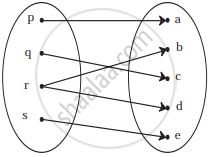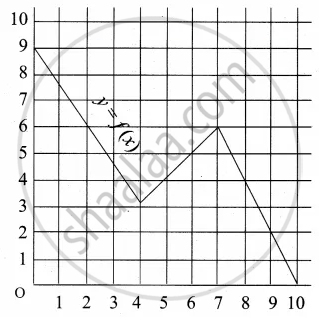Advertisements
Advertisements
Question
The range of f(x) = cos [x], for π/2 < x < π/2 is
Options
(a) {−1, 1, 0}
(b) {cos 1, cos 2, 1}
(c) {cos 1, −cos 1, 1}
(d) [−1, 1]
Solution
(b) {cos 1, cos 2, 1}
Since, f(x) = cos [x], where \[\frac{- \pi}{2} < x < \frac{\pi}{2}\]
\[- \frac{\pi}{2} < x < \frac{\pi}{2}\]
\[ \Rightarrow - 1 . 57 < x < 1 . 57\]
\[ \Rightarrow [x] \in { - 1, 0, 1, 2}\]
\[\text{ Thus } , \cos [x] = {\cos ( - 1), \cos 0, \cos1, \cos 2 }\]
\[\text{ Range of } f(x) = {\cos 1, 1, \cos 2}\]
APPEARS IN
RELATED QUESTIONS
find: f(1), f(−1), f(0) and f(2).
Let f : R → R and g : C → C be two functions defined as f(x) = x2 and g(x) = x2. Are they equal functions?
If \[y = f\left( x \right) = \frac{ax - b}{bx - a}\] , show that x = f(y).
If \[f\left( x \right) = \frac{2x}{1 + x^2}\] , show that f(tan θ) = sin 2θ.
Let f and g be two real functions defined by \[f\left( x \right) = \sqrt{x + 1}\] and \[g\left( x \right) = \sqrt{9 - x^2}\] . Then, describe function:
(iii) f g
If f(x) = loge (1 − x) and g(x) = [x], then determine function:
(iv) \[\frac{g}{f}\] Also, find (f + g) (−1), (fg) (0),
Write the range of the function f(x) = cos [x], where \[\frac{- \pi}{2} < x < \frac{\pi}{2}\] .
If f, g, h are real functions given by f(x) = x2, g(x) = tan x and h(x) = loge x, then write the value of (hogof)\[\left( \sqrt{\frac{\pi}{4}} \right)\] .
Let f and g be two functions given by
f = {(2, 4), (5, 6), (8, −1), (10, −3)} and g = {(2, 5), (7, 1), (8, 4), (10, 13), (11, −5)}.
Find the domain of f + g
If \[f\left( x \right) = \frac{2^x + 2^{- x}}{2}\] , then f(x + y) f(x − y) is equal to
Check if the following relation is function:

A function f is defined as follows: f(x) = 5 − x for 0 ≤ x ≤ 4. Find the value of x such that f(x) = 3
If f(m) = m2 − 3m + 1, find f(−3)
Find x, if f(x) = g(x) where f(x) = x4 + 2x2, g(x) = 11x2
Find the domain and range of the following function.
f(x) = 7x2 + 4x − 1
Express the following exponential equation in logarithmic form
3–4 = `1/81`
Express the following exponential equation in logarithmic form
10−2 = 0.01
Express the following exponential equation in logarithmic form
e–x = 6
Express the following logarithmic equation in exponential form
ln e = 1
Write the following expression as sum or difference of logarithm
In `[(root(3)(x - 2)(2x + 1)^4)/((x + 4)sqrt(2x + 4))]^2`
Given that log 2 = a and log 3 = b, write `log sqrt(96)` in terms of a and b
Solve for x.
x + log10 (1 + 2x) = x log10 5 + log10 6
If f(x) = 3x + 5, g(x) = 6x − 1, then find (fg) (3)
The equation logx2 16 + log2x 64 = 3 has,
Select the correct answer from given alternatives
The domain of `1/([x] - x)` where [x] is greatest integer function is
Answer the following:
For any base show that log (1 + 2 + 3) = log 1 + log 2 + log 3
Answer the following:
Simplify, log (log x4) – log (log x)
Answer the following:
If `log (("a" + "b")/2) = 1/2(log"a" + log"b")`, then show that a = b
Answer the following:
Show that `7log (15/16) + 6log(8/3) + 5log (2/5) + log(32/25)` = log 3
A graph representing the function f(x) is given in it is clear that f(9) = 2

What is the image of 6 under f?
The function f and g are defined by f(x) = 6x + 8; g(x) = `(x - 2)/3`
Write an expression for gf(x) in its simplest form
The range of 7, 11, 16, 27, 31, 33, 42, 49 is ______.
If f(x) = 5x - 3, then f-1(x) is ______
Find the domain of the following function.
f(x) = [x] + x
Find the domain of the following functions given by f(x) = x|x|
Find the domain and range of the function f(x) = `1/sqrt(x - 5)`
Let f(x) = `sqrt(1 + x^2)`, then ______.
The expression \[\begin{array}{cc}\log_p\log_p\sqrt[p]{\sqrt[p]{\sqrt[p]{\text{...........}\sqrt[p]{p}}}}\\
\phantom{...........}\ce{\underset{n radical signs}{\underline{\uparrow\phantom{........}\uparrow}}}
\end{array}\]where p ≥ 2, p ∈ N; ∈ N when simplified is ______.
The period of the function
f(x) = `(sin 8x cos x - sin 6x cos 3x)/(cos 2x cos x - sin 3x sin 4x)` is ______.
